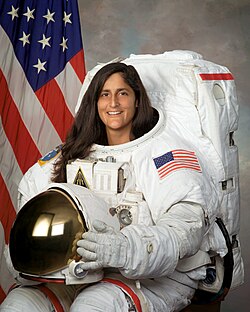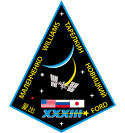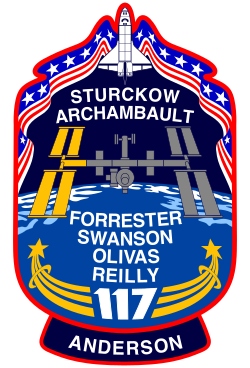Sunita Williams
| Sunita Lyn "Suni" Williams | |
 | |
| NASA-astronaut | |
|---|---|
| Född | 19 september 1965 Euclid, Ohio |
| Tid i rymden | 321 dagar, 17 timmar, 15 minuter |
| Urvalsgrupp | Astronautgrupp 17 |
| Antal rymdpromenader | 7 |
| Rymdpromenadtid | 50 timmar, 40 minuter |
| Uppdrag | STS-116, Expedition 14/15, STS-117, Sojuz TMA-05M, Expedition 32/33, Boe-CFT |
| Uppdragsemblem | |
Sunita Lyn "Suni" Williams (tidigare Pandya), född 19 september 1965 i Euclid i Ohio, är en amerikansk astronaut uttagen i astronautgrupp 17 den 4 juni 1998.
Sunita Williams är den andra kvinnan av indiskt ursprung som blivit vald till ett rymduppdrag av NASA. Den första var Kalpana Chawla, som förolyckades i Columbia-katastrofen under uppdraget STS-107.
Williams anslöt sig till Expedition 14 på ISS som flygingenjör den 10 december 2006. Sunita Williams har kvinnligt rekord i antalet timmar ute på rymdpromenader.
Kuriosa

Hennes intressen är bland annat att springa, simma, cykla, triathlon, vindsurfa och snowboard.
Hon klippte av sin hästsvans, i rymden, och donerade den till en amerikansk förening, Locks of Love, som gör peruker till barn som förlorat sitt hår av medicinska skäl. Frisören var uppdragsspecialist Joan Higginbotham som tog hästsvansen tillbaka till jorden med STS-116.
Hon är den första som sprungit ett maratonlopp i rymden (på löpband). Hon skulle sprungit Boston Marathon 16 april 2007, men sprang på löpband istället eftersom tiden i rymden förlängts.
Familjeliv
Gift med Michael J. Williams. De har inga barn men några hundar.
Karriär
Innan sin utbildning hos Nasa var hon aktiv i USA:s marin som befälhavare. Williams blev antagen av NASA 1998 och har bland annat arbetat i Moskva tillsammans med det ryska rymdprogrammet.
Rymdfärder
- 10 december 2006 - 22 juni 2007. Var en del av Expedition 14. Upp med STS-116, planen var att hon skulle återvända med STS-118, men på grund av förseningar i förberedelserna för STS-117 flygning, så kom hon att återvända med STS-117.
Hon var befälhavare för Expedition 33
- Boe-CFT
Rekord för kvinnliga astronauter
När Sunita Williams landade med STS-117 den 22 juni 2007 blev hon den kvinna som dittills varit längst i rymden. Med 195 dagar i rymden passerade hon därmed Shannon Lucids tidigare rekord på 188 dagar från 1996. Williams innehade även rekordet för rymdpromenader utförda av en kvinna, med 4 rymdpromenader på sammanlagt 29 timmar och 17 minuter.
Källor
”Biographical Data” (på engelska) (PDF). NASA. juni 2022. https://www.nasa.gov/wp-content/uploads/2016/02/williams-s.pdf?emrc=68e643. Läst 5 maj 2024.
|
Media som används på denna webbplats
The Expedition 33 patch depicts the International Space Station (ISS) orbiting around the Earth, and into the future. The national flags of Japan, Russia, and the United States of America represent the crew of Expedition 33, which consists of six astronauts and cosmonauts from Japan, Russia and the United States. The five white stars represent the partners participating in the ISS Program – Canada, European countries, Japan, Russia and the United States. Expedition 33 will continue the work of the previous thirty-two expedition crews on board the multi-national laboratory in areas such as biology and biotechnology, earth and space science, educational activities, human research, physical and material sciences, and technology development and demonstration.
This emblem embodies the past, present, and future of human space exploration. The Roman numeral XIV suspended above the Earth against the black background of space symbolizes the fourteenth expeditionary mission to the International Space Station (ISS), or Международная Космическая Станция. Elements of this symbol merge into a unified trajectory destined for the moon, Mars, and beyond, much as science and operations aboard the ISS today will pave the way for future missions to our celestial neighbors. The five stars honor the astronauts and cosmonauts of missions Apollo 1, Soyuz 1, Soyuz 11, Challenger, and Columbia, who gave their lives in the pursuit of knowledge and discovery.
The operational teamwork between human space flight controllers and the on-orbit crew take center stage in this emblem. Against a backdrop familiar to all flight controllers, past and present, independent of any nationality, the fifteenth expedition to the ISS is represented in Roman numeral form as part of the ground track traces emblazoned on the Mercator projection of the home planet Earth. The ISS, shown in its fully operational, assembly complete configuration, unfurls and then reunites the flags of this Russian and American crew in a show of our continuing international cooperation. Golden spheres placed strategically on the ground track near the flight control centers of the United States and Russia serve to symbolize both the joint efforts from each nation's team of flight controllers and the shuttle and Soyuz crew vehicles in their chase orbit as they rendezvous with the ISS. A rising sun provides a classic touch to the emblem signifying the perpetual nature of manned space flight operations and their origin in these two space-faring nations.
The STS-117 crew patch symbolizes the continued construction of the International Space Station (ISS) and our ongoing human presence in space. The ISS is shown orbiting high above the Earth. Gold is used to highlight the portion of the ISS that will be installed by the STS-117 crew. It consists of the second starboard truss section, S3/S4, and a set of solar arrays. The names of the STS-117 crew are located above and below the orbiting outpost. The two gold astronaut office symbols, emanating from the '117' at the bottom of the patch represent the concerted efforts of the shuttle and station programs toward the completion of the station. The orbiter and unfurled banner of red, white and blue represent our Nation's renewed patriotism as we continue to explore the universe.
Astronaut Sunita Williams, Expedition 14 flight engineer, circled Earth almost three times as she participated in the Boston Marathon from space. She is seen here with her feet off the station treadmill on which she ultimately ran about six miles per hour while flying more than five miles each second
This patch represents the 32nd expedition to the International Space Station (ISS) and the significance of the science being conducted there for current and future generations. The arch shape of the patch symbolizes the "doorway" to future space exploration possibilities. The ISS, an orbiting laboratory above the Earth, provides a unique perspective for Earth observation and monitoring. The flame depicts the pursuit of knowledge and highlights the importance of education as the key to future human space flight. The astronaut symbol circles the Earth, acknowledging the work of all astronauts, past, present, and future. The names of each crew member located on the border of the patch are written to honor the various cultures and languages on the mission. The three flags also depict the home countries of the Expedition 32 crew members and signify the collaborative ISS partnership of 15 countries working as one.








